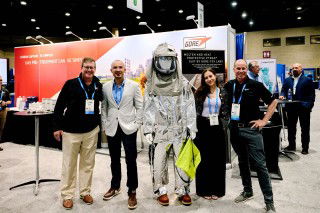The annual Cemtech Middle East & Africa International Cement Conference and Exhibition took place at the Four Seasons Resort, Marrakech, Morocco, on 10-13 February 2013. Supported by the Association Professionnelle des Cimentiers (APC), this meeting drew strong support from the local industry, and was formally opened by Mohamed Chaïbi, president of the APC and CEO of Italcementi subsidiary, Ciments du Maroc.
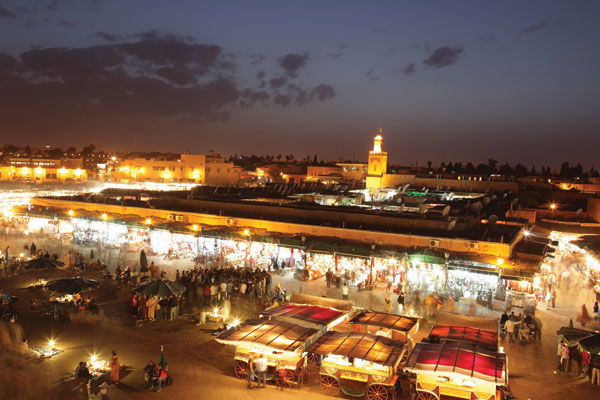
Nestled in the foothills of the snow-capped Atlas mountains in southwest Morocco,
Marrakech is renowned for being one of North Africa’s most evocative cities
Nestled in the foothills of the snow-capped Atlas mountains in southwest Morocco, Marrakech is renowned for being one of North Africa’s most evocative cities. For three days in mid-February, it was also home to some 230 cement industry professionals from 35 countries, who convened at the impressive Four Seasons Resort for intensive discussions, presentations and networking at the 8th Cemtech Middle East and Africa conference.

Mohamed Chaïbi, president of the Moroccan Cement
Association and CEO of Italcementi subsidiary, Ciments du
Maroc, opened the event with a keynote speech highlighting
the emergence of Morocco as a major regional producer
Opening the event, Mohamed Chaïbi, president of the Moroccan Cement Association, made an impressive keynote speech highlighting the status of the domestic market as a major regional producer. He noted the ongoing sustainability efforts, which have transformed the industry into a ‘net de-polluter’, a useful concept to describe the activities of the cement industry and its environmental contribution to society. The industry, which operates 21Mta of capacity at present against a consumption of 15.9Mt in 2012, is set to invest €0.9bn in establishing 3.5Mta of greenfield capacity while there are a potential 3Mta of upgrade projects also planned.
The session then continued with a focus on the global and regional cement sector, market trends and new capacity developments in West Africa.
Global overview
Yuri Serov of Morgan Stanley presented an expert analysis of worldwide consumption trends and observed that global demand is set to recover growth momentum in 2013, after 2012 finished up recording the slowest growth since 2001. Consumption will exceed 4bnt in 2014, even though demand in China has peaked. On average cement consumption per capita tends to peak around 600kg, and using this as a guide, consumption in China has clearly reached unsustainable levels and will now start to decline. Global capacity utilisation fell again in 2012, but growth will return this year and increase thereafter. The prospects for Europe remain dire unless substantial capacity closures kick in, while demand in the MENA region is set to expand by 2.9 per cent in 2013 and sub-Saharan Africa (driven by Nigeria) will see a healthy 5.8 per cent expansion this year.
African industry developments
A major theme that soon emerged from the morning’s presentations was the scale of build-up in capacity taking place in sub-Saharan Africa. Trond Waerp, CEO of Nouvelle Cimenterie du Niger, which is currently building a new line near Niamey, offered a comprehensive analysis of West African cement markets which is seeing strong advances in consumption fuelled by economic growth and a focus on infrastructure spending. Heavy investment into new capacity – particularly from the emerging groups such as Dangote and WACEM – are seeing the region transformed from being a market for surplus capacity overseas to becoming self-sufficient and even net exporters. At present, demand in the region stands at 34.8Mt, and is expected to rise to 45.5Mt by 2015. But surplus capacity in the region, he warned, could exceed 9Mta and 7Mta for cement and clinker, respectively by 2015.
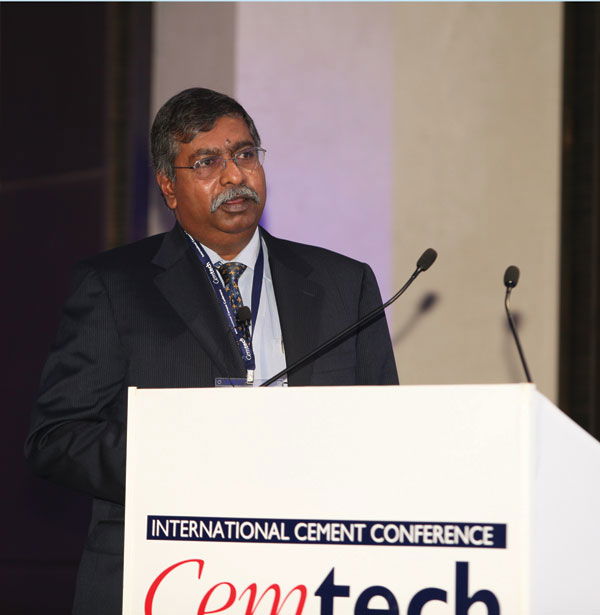
DVG Edwin, CEO, Dangote Cement Plc, presents the
company’s pan-African expansion strategy to Cemtech delegates
DVG Edwin, CEO, Dangote Cement Plc presented the current status of the Nigerian market leader, which is on course to establish 29Mta of integrated capacity in the country by 2015, up from just 11Mta in 2012. This extraordinary growth will be repeated across the continent, where a further 15.8Mta of cement capacity is being established in countries stretching from Senegal in the west to Tanzania in the east. Looking ahead, however, the company does not see itself as a pure African player, and is actively seeking new investments in all other emerging market territories from Latin America to Asia.
Further evidence of the emerging players increasing their presence in the region was provided by Ciments de l’Atlas (CIMAT). Youssef Benhachem presented an overview of the group’s two new 1.6Mta greenfield plants at Ben Ahmed and Beni Mellal. Owned by one of Morocco’s leading businessmen, Anas Sefrioui, the plants were constructed on a semi-turnkey basis by Polysius SAS and executed in record time. This was in part enabled by a ‘copy-paste’ approach to using plants with broadly similar specifications and launched consecutively, allowing experiences of the first line to support the accelerated erection of the second line.
CIMAT’s sister company, Ciments de l’Afrique (CIMAF) is in the process of rolling out a series of 0.5Mta grinding plants across West Africa, with three operations nearing completion in the Ivory Coast, Guinea and Cameroon and a further three planned for Burkina Faso, Gabon and Congo. Director general Abdessamad Sefrioui was on hand to highlight the projects, which will be served by surplus clinker from the two Moroccan plants.
Moving over to East Africa, Harpreet Duggal, Binani (UAE), provided a fine analysis of supply and demand trends in a region where per capita cement consumption is lowest in Africa. He noted the strong potential for East Africa, which is a promising market for cement producers provided they are able to identify the pockets of unserved demand that exist, in spite of the significant new capacities under construction.
Ad Ligthart (The Netherlands), author of ICR’s forthcoming Handbook on Global Cement Trade & Distribution, presented a regional view of cement trade, mapping the main maritime distribution networks and providing examples of import terminals in the region. For Africa, where poor infrastructure usually prevails, operators should create shipunloading possibilities that do not require a port, and instead install low-cost, moveable facilities where political risk is high.
Management and finance
The remainder of the first day centred on topics relating to management and finance. Managing the performance of African operations was the subject of a presentation by Tony Hadley, ex-head of Lafarge’s African operations. He provided inspirational insights into the options available to managers on the continent to improve operational efficiency in Africa. Moving to finance, Florence Bachelard-Bakal, senior banker at the EBRD, highlighted the bank’s new mandate to fund projects in North Africa, with finance now available for new plant projects in Egypt, Morocco, Tunisia and Jordan. Bryanne Tait of E.ON Masdar Integrated Carbon then presented an innovative finance offering for waste heat recovery systems in the cement sector, based on a build-own-operate-transfer (BOOT) structure, which can allow producers to install a system resulting in a potential US$25m saving over the first 20 years of the investment.
Manufacturing technology
Day two of the meeting saw presentations made on all aspects of the cement manufacturing process, from quarry to the factory gate.
Fabio Iurzolla (Bedeschi, Italy) gave delegates a tour of Bedeschi’s crushing and raw material handling equipment, illustrated with two Morrocan references. At Lafarge’s Tetouan II works, Bedeschi supplied engineering services plus conveyors, stacker-reclaimers and feeders for limestone, coal and additive storage.
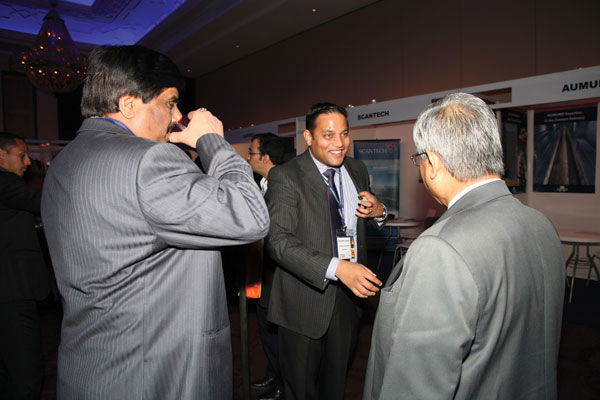
Scantech at work in the exhibition area
ThermoFisher’s Carsten Wiedmann offered an innovative approach to raw meal composition and quality control via the AccuLink software module. This combines both online elemental analysis from the cross-belt analyser positioned before the raw mill with sampling from the XRF laboratory analysers. The hourly LSF standard deviation of the kiln feed can thereby be reduce by up to 20 per cent, reducing energy consumption in the process.
Energy and alternative fuels
Lawrie Evans (Italcementi Group) provided a masterclass on energy reduction opportunities in cement plants, with a candid assessment of the various merits of different technologies, and the practical measures cement plant operators can take to audit and improve energy performance throughout the plant. Cement milling, which consumes approximately 40 per cent of total power in a plant, is the primary focus for optimisation, and Italcementi have been most impressed with the application of an ‘expert’ system which resulted in six per cent power savings while increasing output by 10 per cent.
Tom Lowes of Cinar (UK) demonstrated his extensive experience and process knowledge, setting out the fundamental practical rules to achieve 100 per cent petcoke utilisation, even with a high sulphur petcoke, with no drop in output and NOx below 500mb/Nm3 (withough SNCR). This is achieved by combining process knowledge, backed up with CFD modelling to provide a low capex solutions.
Alternative fuels utilisation was a key area for discussion, with a thought-provoking presentation on the co-processing of wastes in cement kilns by Jean-Pierre Degré of Cementis (Switzerland). His key message was that current waste management practices leave a substantial part of the resource potential of waste unused and that the cement industry is uniquely positioned to recover these resources through co-processing. The opportunity is there to be captured.
Dr Hubert Baier of Vecoplan FuelTrack (Germany) then led the meeting with a discussion on alternative fuel systems for cement plants, setting out the practical areas required to identify, prepare and use alternative fuels in cement plants. In addition to offering shredders and screens for waste co-processing, Vecoplan also offer a specially-developed long-distance conveyor system using a belt inside a closed tube sliding on an air cushion. Finally, one important consideration for plant operators is to align the pyroprocess with the intended fuels.
Moving down the line, Jean-Baptiste Agnes of Claudius Peters (Germany) showed the ETA clinker cooler system, which was introduced in 2004 and has subsequently been installed in 54 plants worldwide, can be retrofitted to replace inefficient grate clinker coolers.
Harald Halle of Gebr Pfeiffer provided a case study of the new cement grinding plant at Les Ciments de Gabès in Tunisia, featuring the MPS 4250BC vertical roller mill, while Laurent Guillot of Chryso gave an excellent demonstration of how cement enhancers can be used to achieve high limestone addition levels in cements, while still increasing cement strengths.
Orhan Celik of Dal Engineering Group, Turkey, presented the group’s engineering capabilities in designing and building low capex grinding units, while Mario Rocchetti of FLSmidth Ventomatic showed delegates a fascinating video demonstration of the latest high-capacity packing lines for efficient dispatch and distribution for cement.
An alternative perspective within the technical programme was provided by industrial architect Thierry Bogaert, who gave an absorbing presentation showing how the visual impact of cement plants could be enhanced through the creative use of materials and colours, with case studies from his global portfolio of projects.
Exhibition
One of the core objectives for Cemtech conferences is to provide the industry with a platform from which to share insights and experiences of best practice for cement manufacturing, and to promote more efficient, sustainable and profitable industrial activities. To this end, the accompanying exhibition offered participants the opportunity to engage with a range of experts and equipment suppliers, offering the full range of services to the global cement sector.
Technical workshop
On the final day of the meeting a technical workshop entitled: “Process knowledge empowers product development” was offered free of charge to delegates and led by Dr Michael Clark (CemNet e-Learning moderator) who tackled the issue of establishing a successful blended cement strategy. Approaching the topic from a process technology perspective, this workshop offered an additional resource to production engineers attending the conference with an interest in personal development and extending their knowledge base.
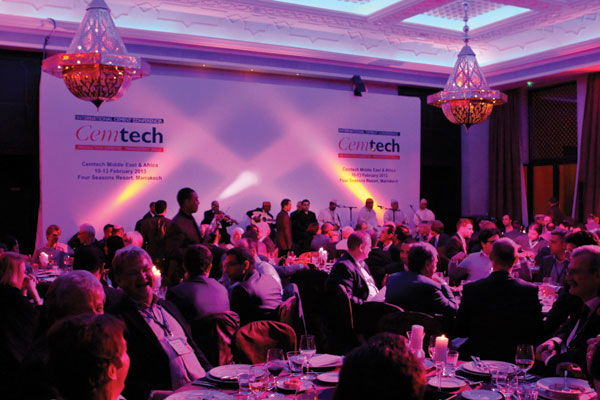
The Gala Dinner offered a superb finale
Cemtech MEA 2013 was held in the fabulous Four Seasons Resort in Morocco, and featured Cemtech’s legendary hospitality throughout, including spouse tours of Marrakech and a superb Gala Dinner finale in true Moroccan style. The meeting will return to the Middle East and Africa region in 2014, following events in Asia and Europe in the second half of 2013.
Article first published in International Cement Review, April 2013.
